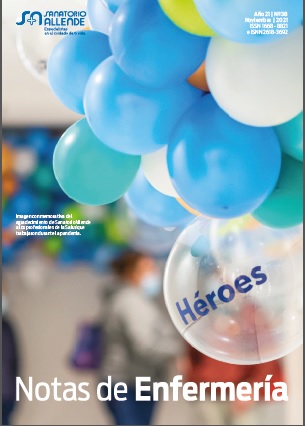Use and Administration of rtPA (tissue plasminogen activator): nursing care
DOI:
https://doi.org/10.59843/2618-3692.v21.n38.35421Keywords:
rtPA, Administration, care, nursing, high riskAbstract
Although the use of rtPA is indicated for various pathologies such as thrombolytic treatment in acute myocardial infarctions, acute pulmonary thromboembolism with hemodynamic instability, and thrombolytic treatment of acute ischemic stroke according to the DI-2018-495-APN-ANMAT provision. #MSYDS the use of thesame in Argentina and accordingtoconsensus (consensus on accident cerebrovascular ischemico acute). Timely administration of rtPA to appropriately selected patients constitutes the main treat mentearly in stroke (1,8). Therefore, the role play edby nursingis fundamental in the risk ass essment prior to the administration, preparation, administration of the drug, and continuous postadministration assessment.
Downloads
References
1. PIGRETTI SANTIAGO G, ALET MATÍAS J., MAMANI CARLOS E., ALONZO CLAUDIA, AGUILAR MARTÍN, ÁLVAREZ HÉCTOR J., AMERISO SEBASTIÁN,. ANDRADE MARÍA G, ARCONDO FLORENCIA, ARMENTEROS CRISTIAN, ARROYO JOSÉ, BEIGELMAN RICARDO, BONARDO PABLO, BULLRICH MARÍA BRES, CABELLO CECILIA, GONZALO CAMARGO, CAMERLINGO SEBASTIÁN, CÁRDENAS ROLANDO, CHÁVES HERNÁN, CIARDI CELINA y otros “CONSENSO SOBRE ACCIDENTE CEREBROVASCULAR ISQUÉMICO AGUDO” MEDICINA (Buenos Aires) 2019; Vol. 79 (Supl. II): 1-46. Consultada Junio 2021. Disponible en http://www.sagg.org.ar/wp/wp-content/uploads/2019/06/Consenso_
ACV-D.pdf
2. M. ALONSO DE LECIÑANAJ.A. EGIDOI. CASADOM. RIBÓA. DÁVALOSJ. MASJUANJ. L. CANIEGOE. MARTÍNEZ VILAE. DÍEZ TEJEDOR (COORDINADOR)POR EL COMITÉ AD HOC DEL GRUPO DE ESTUDIO DE ENFERMEDADES CEREBROVASCULARES DE LA SEN:B. FUENTES
(SECRETARÍA)J. ÁLVAREZ-SABINJ. ARENILLASS. CALLEJAM. CASTELLANOSJ. CASTILLOF. DÍAZOTEROJ. C. LÓPEZ-FERNÁNDEZ…J. VIVANCOS. Guía para el tratamiento del infarto cerebral agudo Guidelines forthe treatment of acute ischaemic stroke- Volumen 29, Issue 2, March 2014, Pages 102-122
3. OLIVEIRA, J; FILHO, S; SILVA, C; TRABUCO, B; PEDREIRA, E; SOUSA, A; et al.Detrimentaleffect of bloodpressurereduction in thefirst 24 hours of acutestrokeonsetNeurology, 61 (2003), pp. 1047-1051.Consultada Junio 2021. Disponible en: CrossRefView Record in ScopusGoogleScholarView in article
4. M.S. DENNIS, S.C. LEWIS, C. WARLOW, FOOD Trial Collaboration: Effect of timing and method of enteral tubefeedingfordysphagicstrokepatients (FOOD): a multicentrerandomisedcontrolled trial Lancet, 365 (2005), pp. 764-772.
5. P. LANGHORNE, P. DUNCAN: Does the organization of post acute stroke care really matter? Stroke, 32 (2001), pp. 268-274
6. Instituto Nacional de Trastornos Neurológicos y Accidentes CerebrovascularesNIH. Consultada Junio 2021. Disponible en: https://espanol.ninds.nih.gov/es.
7. American Heart Association. Heart Attack and Stroke Symptoms Consultada Junio 2021. Disponible en https://www.heart.org/en/about-us/heart-attack-and-stroke-symptoms
8. Disposición DI–2018-495- APN-ANMAT#MSYDS – Referencia 1- 0047- 1110- 000409- 17-6.Consultada Junio 2021.Disponibleen:
http://www.anmat.gov.ar/boletin_anmat/septiembre_2018/Dispo_MSYDS_0495-18.pdf.
9. JUAN I. ROJAS, MARIA CRISTINA ZURRU, LILIANA PATRUCCO, MARINA ROMANO, PATRICIA M. RICCIO, EDGARDO CRISTIANO (2006) REGISTRO DE ENFERMEDAD CEREBROVASCULAR ISQUEMICA MEDICINA Buenos Aires 66: 547-551 ISSN 0025-7680.Consultada Junio 2021. Disponible en http://www.scielo.org.ar/pdf/medba/v66n6/v66n6a08.pdf
10. JAUCH EC, SAVER JL, ADAMS HP, et al. (2013)Guidelines for the Early Management of Patients With Acute Ischemic Stroke: A Guideline for Healthcare Professionals From the American Heart Association/American Stroke Association. Stroke 2013; 44: 870-947.Consultada Junio 2021. Disponible en:https://www.ahajournals.org/doi/10.1161/STR.0b013e318284056a
11. ORTIZ-PRADO E, BANDERAS LEÓN A, UNIGARRO L Y SANTILLAN P (2018). Oxigenación y Flujo Sanguíneo Cerebral, Revisión Comprensiva de la Literatura. Rev. Ecuat. Neurol. Vol. 27, No 1, 2018. Consultada Junio 2021. Disponibleen:http://revecuatneurol.com/wp-content/uploads/2018/09/Oxigenacio%CC%81n-y-Flujo-Sangui%CC%81neo-Cerebral.pdf.
12. OPS-OMS. Carta de Ottawa para la promoción de la salud La primera Conferencia Internacional sobre la Promoción de la Salud reunida en Ottawa el día 21 de noviembre de 1986 emite la CARTA dirigida a la consecución del objetivo "Salud para Todos en el año 2.000". Esta conferencia fue, ante todo, una respuesta a la creciente demanda de una nueva concepción de la salud pública en el mundo.Consultada Junio 2021. Disponible en https://www.paho.org/hq/dmdocuments/2013/Carta-de-ottawa-para-la-apromocion-de-lasalud-1986-SP.pdf
13. POWERS WJ, RABINSTEIN AA, ACKERSON T, ADEOYE OM, BAMBAKIDIS NC, BECKER K, et al. 2018 guidelines for the early management of patients with acute ischemic stroke: a guideline for healthcare professionals from the American Heart Association/ American Stroke Association. Stroke. 2018:46-110.
14. CAROLINA GARCÍA ALFONSO, ANDREA MARTÍNEZ REYES, VALENTINA GARCÍA, ANDRÉS RICAURTE-FAJARDO, ISABEL TORRES, JULIANA CORAL(2019), “Actualización en diagnóstico y tratamiento del ataque cerebrovascular isquémico agudo” Universitas Medica, vol. 60, núm. 3, 2019 Pontificia Universidad Javeriana. Consultada Junio 2021. Disponible en : https://doi.org/10.11144/Javeriana.umed60-3.actu
15. SCHNEIDER A, PANCIOLI A, KHOURY J, RADEMACHER E, TUCHFARBER A, MILLER R, WOO D, KISSELA B, BRODERICK J (2003):Tendencias en el conocimiento de la comunidad sobre las señales de advertencia y los factores de riesgo del accidente cerebrovascular. JAMA 2003; 289: 343–346.
16. MÜLLER-NORDHORN J, NOLTE C, ROSSNAGEL K, JUNGEHÜLSING G, REICH A, ROLL S, VILLRINGER A, WILLICH S (2006) Conocimiento sobre los factores de riesgo de accidente cerebrovascular. Una encuesta poblacional con 28.090 participantes. Accidente cerebrovascular 2006; 37: 946–950.
17. European Stroke Organization (ESO) Executive Committee Writing Committee(2008) Guidelines for management of ischaemic stroke and transient ischaemic attack 2008. CerebrovascDis 2008; 25: 457-507. Consultada Junio 2021. Disponible en: https://www.karger.com/Article/Pdf/13108318. KUMAR S, DOUGHTY C, DOROS G, SELIM M, LAHOTI S, GOKHALE S, et al. Recovery of swallowing after dysphagic stroke: An analysis of prognostic factors. J Stroke Cerebrovasc Dis. 2012;21 (2):1-7.
19. American Speech-Language-Hearing Association (ASHA). (2002). Roles of speech-language pathologists in swallowing and feeding disorders [Position Statement].Consultada Junio 2021. Disponible en https://ugc.futurelearn.com/uploads/files/94/9e/949e14c3-5410-4d16-81a4-255b924646ce/Roles_of_Speech-Language_Pathologists_in_Swallowing_and_Feeding_Disorders__Technical_Report.pdf
20. Minsterio de Salud, Comunidad Autónoma del País Vasco (2017)GUÍA DE ACTUACIÓN PARA LA PREVENCIÓN Y CUIDADOS DE LAS ÚLCERAS POR PRESIÓN Osakidetza. ISBN:978-84-944367-2-7octubre de 2017. Consultada Junio 2021. Disponible en: https://www.osakidetza.euskadi.eus/contenidos/informacion/osk_publicaciones/es_publi/adjuntos/enfermeria/UPP_es.pdf
21. DE VICENTE 21 LUCIANO, FERNÁNDEZ SILVIA SUSANA; CAMARGO GABRIELA LILIANA (2018)“GESTIÓN PARA VALORAR RIESGOS Y REGISTRAR LA EVOLUCIÓN DE LAS ÚLCERAS POR PRESIÓN”. III Jornada De Investigación en Enfermería Proceso Enfermero. “Fundamento para la investigación de la Práctica profesional” UNSL, 21 de noviembre del 2018.
22. BRAUNSTEIN 22. EVAN M. (2020) ANEMIA DEBIDA A HEMORRAGIA ABUNDANTE. Johns Hopkins School of Medicine Última revisión completa sep. 2020. Consultada Junio 2021. Disponible enhttps://www.msdmanuals.com/es-ar/hogar/trastornos-de-la-sangre/anemia/anemia-debida-a-hemorragiaabundante
Downloads
Published
Issue
Section
License
Copyright (c) 2021 Sanatorio Allende

This work is licensed under a Creative Commons Attribution-NonCommercial 4.0 International License.
Those authors who have published with this journal, accept the following terms:
- Attribution — You must give appropriate credit, provide a link to the license, and indicate if changes were made. You may do so in any reasonable manner, but not in any way that suggests the licensor endorses you or your use.
- NonCommercial — You may not use the material for commercial purposes.

